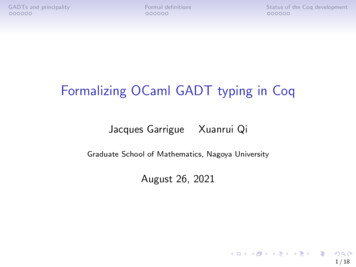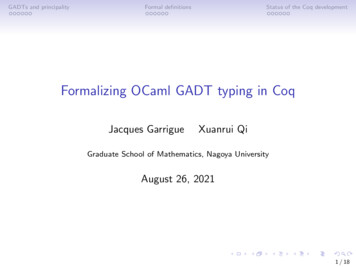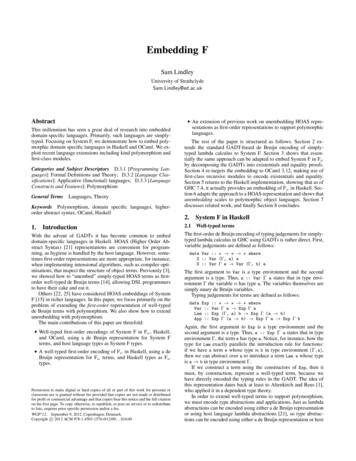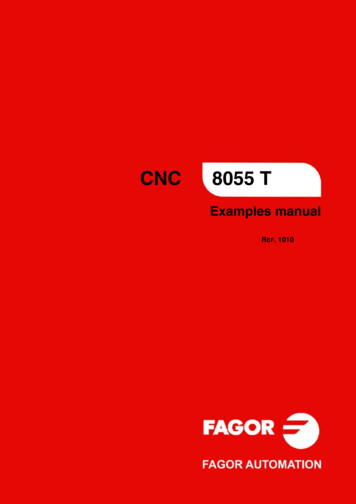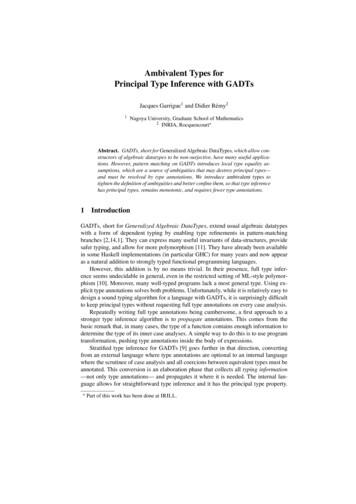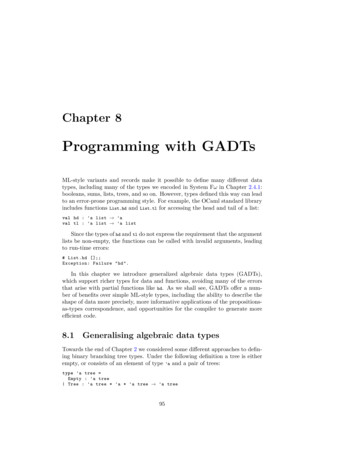
Transcription
Chapter 8Programming with GADTsML-style variants and records make it possible to define many different datatypes, including many of the types we encoded in System F𝜔 in Chapter 2.4.1:booleans, sums, lists, trees, and so on. However, types defined this way can leadto an error-prone programming style. For example, the OCaml standard libraryincludes functions List.hd and List.tl for accessing the head and tail of a list:val hd : 'a list 'aval tl : 'a list 'a listSince the types of hd and tl do not express the requirement that the argumentlists be non-empty, the functions can be called with invalid arguments, leadingto run-time errors:# List.hd [];;Exception: Failure "hd".In this chapter we introduce generalized algebraic data types (GADTs),which support richer types for data and functions, avoiding many of the errorsthat arise with partial functions like hd. As we shall see, GADTs offer a number of benefits over simple ML-style types, including the ability to describe theshape of data more precisely, more informative applications of the propositionsas-types correspondence, and opportunities for the compiler to generate moreefficient code.8.1 Generalising algebraic data typesTowards the end of Chapter 2 we considered some different approaches to defining binary branching tree types. Under the following definition a tree is eitherempty, or consists of an element of type 'a and a pair of trees:type 'a tree Empty : 'a tree Tree : 'a tree * 'a * 'a tree 'a tree95
96CHAPTER 8. PROGRAMMING WITH GADTSTE1Tree(Empty ,1,Tree(Empty ,2,Tree (Empty , 3, Empty)))TE2TE 3 EFigure 8.1: A right skewed tree valueT3TT2EETree(Tree(Tree (Empty , 1, Empty),2,Empty),3,Empty)E 1 EFigure 8.2: A left skewed tree valueTTE 1 E2Tree(Tree (Empty , 1, Empty),2,Tree (Empty , 3, Empty))TE 3 EFigure 8.3: A balanced tree valueUsing the constructors of tree we can build a variety of tree values. Forexample, we can build trees that are skewed to the right (Figure 8.1) or to theleft (Figure 8.2), or whose elements are distributed evenly between left and right(Figure 8.3).Alternatively we can give a definition under which a tree is either empty, orconsists of an element of type 'a and a tree of pairs1 :type ntree EmptyN : 'a ntree TreeN : 'a * ('a * 'a) ntree 'a ntreeThe constructors of ntree severely constrain the shape of trees that can bebuilt. Since the element type of each subtree 'a*'a duplicates the element type'a of the parent , the number of elements at each depth precisely doubles, and1 The perfect type of Chapter 2 defined trees with labels at the leaves rather than at thebranches. The definition of ntree given here makes it easier to compare the various tree typesin this chapter.
8.1. GENERALISING ALGEBRAIC DATA TYPEST1ET2T(1, 3)E97T4T(3, 5)T((1, 2), (6, 7))ETreeN(1, EmptyN)TreeN(2, TreeN((1 ,3),EmptyN))TreeN(4, TreeN((3 ,5),TreeN (((1 ,2) ,(6,7)),EmptyN)))Figure 8.4: Perfectly-balanced treesthe elements are distributed evenly to the left and to the right. As a result, theonly trees that can be built are perfectly balanced trees whose elements numberone less than a power of two (Figure 8.4).The definition of ntree is non-regular because the type constructor it defines,ntree, is not uniformly applied to its type parameters in the definition: instead,it is instantiated with 'a * 'a in the argument of TreeN. We call such non-regulartypes nested. Allowing the return types of constructors to vary in a similar waygives us a variety of non-regular types known as generalized algebraic data types(GADTs).Our first example of a GADT definition involves a couple of auxiliary typesfor natural numbers:type z Z : ztype 'n s S : 'n 'n sFor each natural number n, the types z and s allow us to construct a typewhose single inhabitant represents n. For example, the number three is represented by applying S three times to Z:# S (S (S Z));;- : z s s s S (S (S Z))Initially we will be mostly interested in the types built from z and s ratherthan the values which inhabit those types.The types z and s are not themselves GADTs, but we can use them to builda GADT, gtree, that represents perfect trees:type ('a, ) gtree EmptyG : ('a,z) gtree TreeG : ('a,'n) gtree * 'a * ('a,'n) gtree ('a,'n s) gtree
98CHAPTER 8. PROGRAMMING WITH GADTST[3]T[2]T[1]E 1 ET[1]E 1 E2T[2]T[1]E 3 ET[1]E 1 ETreeG(EmptyG ,1,EmptyG)TreeG(TreeG (EmptyG ,1,EmptyG),2,TreeG (EmptyG ,3,EmptyG))24T[2]T[1]T[1]E 3 EE 5 E6T[1]E 7 ETreeG(TreeG(TreeG (EmptyG , 1, EmptyG),2,TreeG (EmptyG , 3, EmptyG)),4,TreeG(TreeG (EmptyG , 5, EmptyG),6,TreeG (EmptyG , 7, EmptyG))Figure 8.5: Perfect trees using GADTs(The bracketed numbers indicate the depth of the subtree.)The definition of gtree corresponds to the definition of tree, but with anadditional parameter for representing the depth of the tree. For the emptytree EmptyG the parameter is instantiated to z, reflecting the fact that emptytrees have depth zero. For branching trees built with the TreeG constructor thedepth parameter is instantiated to 'n s, where 'n is the depth of each of the twosubtrees. There are two constraints introduced by this second instantiation:first, the subtrees are constrained to have the same depth 'n; second, the depthof the tree built with TreeG is one greater than the depth of its subtrees.It is the different instantiations of the second type parameter in the returntypes of EmptyG and TreeG which make gtree a GADT. We call parameters whichvary in constructor return types indexes.As with ntree, the constructors of gtree constrain the trees that we canbuild. Since both subtrees of each branch are constrained by the type of TreeGto have the same depth, the only values of type gtree are perfectly balancedtrees. Figure 8.5 gives some examples.8.1.1 Functions over GADTsThe gtree type illustrates how relaxing the regularity conditions on the typesof data type constructors make it possible to impose interesting constraintson the shape of data. However, constructing data is somewhat less than halfthe story: the most interesting aspects of GADT behaviour are associated with
8.1. GENERALISING ALGEBRAIC DATA TYPES99TTb E1 max(1 max 0 0)0E a Elet rec depth : 'a.'a tree int functionEmpty 0 Tree (l, ,r) 1 max (depth l) (depth r)TTbE Some bE a Elet top : 'a.'a tree 'a option functionEmpty None Tree ( ,v, ) Some vTTE a EbTE EbTE a Elet rec swivel : 'a.'a tree 'a tree functionEmpty Empty Tree (l,v,r) Tree (swivel r, v, swivel l)Figure 8.6: Functions over unconstrained binary treesdestructing values passed as function arguments. We will now consider a numberof functions which destruct trees passed as arguments to illustrate how GADTshave certain clear advantages over regular and nested data types.Functions over tree Figure 8.6 shows the implementations of three functionsover the regular tree type tree. The first, depth, computes the depth of a tree,defined as zero if the tree is empty and the successor of the maximum of thedepths of the left and right subtrees otherwise. The second, top, retrieves theelement nearest the root of the argument tree, and returns an option value inorder to account for the case where argument is empty. The third, swivel, rotatesthe tree around its central axis.The types of depth, top and swivel are straightforward, but fairly uninformative. The type of depth tells us that the function accepts a tree and returnsan int, but there is nothing in the type that indicates how the two are related.
100CHAPTER 8. PROGRAMMING WITH GADTSIt is possible to write functions of the same type that compute the number ofelements in the tree rather than the depth, or that compute the number of unbalanced branches, or that simply return a constant integer. The type of swivelis slightly more informative, since we can apply parametricity-style reasoning toconclude that every element in the output tree must occur in the input tree, butwe cannot say much more than this. It is possible to write functions with thesame type as swivel that return an empty tree, ignoring the argument, or thatduplicate or exchange nodes, or that simply return the argument unaltered.Functions over ntree Figure 8.7 shows the implementation of functions corresponding to depth, top and swivel for the ntree type.The implementations of depthN and topN correspond quite directly to theircounterparts for the tree type. Since all values of type ntree are perfectly balanced, it is sufficient for depthN to measure the spine rather than computingthe maximum depth of subtrees. One additional point is worth noting: since anon-empty value of type 'a ntree has a subtree of type ('a * 'a) ntree, depthN isan example of polymorphic recursion (Section 3.4.2).The implementation of swivelN is less straightforward, since it deals recursively with elements, and the element type changes as the depth increases. Theauxiliary function swiv accepts a function f which can be used to swivel elementsat a particular depth. At the point of descent to the next level, f is used toconstruct a function fun (x,y) (f y,f x) that can be used to swivel elementsone level deeper.Functions over gtree Figure 8.8 shows the implementation of functions corresponding to depth, top and swivel for gtree.Locally abstract types The first thing to observe is the new syntax in thetype signatures: the prefix type a n introduces two type names a and n that arein scope both in the signature and in the accompanying definition. These namesdenote so-called locally abstract types, and together with GADTs they supporttype-checking behaviour known as type refinement.Type refinement Under standard pattern matching behaviour, matching avalue against a series of patterns reveals facts about the structure of the value.For example, in the depth function of Figure 8.6, matching the argument determines whether it was constructed using Empty or Tree. It is only possible toextract the element from the tree in the Tree branch, since the variable v whichbinds the element is not in scope in the Empty branch.Type refinement extends standard pattern matching so that matching reveals facts both about the structure of the value and about its type. Since theconstructors of a GADT value have different return types, determining whichconstructor was used to build a value reveals facts about the type of the value(and sometimes about other values, as we shall see later). Let’s consider theimplementation of depthG to see how refinement works.
8.1. GENERALISING ALGEBRAIC DATA TYPESTa1 T(b, c)1 1 T((d, e), (f, g))0Elet rec depthN : 'a.'a ntree int functionEmptyN 0 TreeN ( ,t) 1 depthN tTa T(b, c)Some aElet rec topN : 'a.'a ntree 'a option functionEmptyN None TreeN (v, ) Some vTaT(b, c)Ta T(c, b)T((d, e), (f, g))T((g, f), (e, d))EElet rec swiv : 'a.('a 'a) 'a ntree 'a ntree fun f t match t withEmptyN EmptyN TreeN (v,t) TreeN (f v, swiv (fun (x,y) (f y, f x)) t)let swivelN p swiv id pFigure 8.7: Functions over perfect trees101
102CHAPTER 8. PROGRAMMING WITH GADTST[2]T[1]bE d ES (depthT[1] S (depthZ))E e Elet rec depthG : type a n.(a, n) gtree n functionEmptyG Z TreeG (l, , ) S (depthG l)T[2]T[1]aE b ET[1] aE c Elet topG : type a n.(a,n s) gtree a function TreeG ( ,v, ) vT[2]T[1]E b EaT[2]T[1]E c E T[1]E c EaT[1]E b Elet rec swivelG : type a n.(a,n) gtree (a,n) gtree functionEmptyG EmptyG TreeG (l,v,r) TreeG (swivelG r, v, swivelG l)Figure 8.8: Functions over perfect trees using GADTs
8.1. GENERALISING ALGEBRAIC DATA TYPESHere’s the signature of103depthG:type a n.(a, n) gtree nKnowing the interpretation of the second type parameter, we might readthis as follows: depthG takes a gtree with element type a and depth n and returnsthe depth n. Thus for an empty tree we expect depthG to return Z, and for a treeof depth three we expect it to return S (S (S Z)). However, these have different(and incompatible) types, and the normal type checking rules require that everybranch of a match have the same type. Type refinement addresses exactly thisdifficulty. The first branch is executed if the value was built with EmptyG:EmptyG ZLooking back to the definition ofeter instantiated with z:EmptyG(page 97) we find the depth param-EmptyG : ('a,z) gtreeIt is therefore reasonable to draw the following conclusion: if the first branchis executed, then the type equality n z must hold, and we can freely exchangen and z in the types of any expression within this branch. In particular, theexpression Z, which has type z, can also be given the type n, which is exactlywhat is needed to satisfy the signature.Similarly, the second branch is executed if the value was built with TreeG: TreeG (l, , ) S (depthG l)In the definition ofTreeGthe depth parameter is instantiated with'n s: TreeG : ('a,'n) gtree * 'a * ('a,'n) gtree ('a,'n s) gtreeIf this branch is executed then we can draw the following series of conclusions:1. The type equality n 'n s must hold for some unknown type variable 'nand we can freely exchange n and z in the types of any expression withinthis branch2. According to the type of the TreeG constructor the first constructor argument l has type (a, 'n) gtree.3. The recursive calldepthG l4. The application of theStherefore has typeconstructorS'n.(depthG l)therefore has type'n s.5. Since n 'n s, the expression S (depthG l) can be given the type n, whichis exactly what is needed to satisfy the signature.There’s quite a lot going on to type check such a simple definition! It is onlybecause we have specified the expected type of the function that type checkingsucceeds; there is no hope of inferring a principal type. There are at least threereasons why the type inference algorithm of Chapter 3 cannot be expected todetermine a type for depthG:
104CHAPTER 8. PROGRAMMING WITH GADTS1. The definition is polymorphic-recursive, since the argument passed todepthG has a different type to the parameter in the definition. We sawin Section 3.4.2 that polymorphic recursion is incompatible with type inference.2. The type of the variable l is existential, which is a more formal way ofsaying the same thing as “for some unknown type variable ’n”’ above.We saw in Chapter 6 that type inference for general existential types isundecidable.3. Type refinement is not generally compatible with inference, since the typechecker needs to know in advance what is being refined. We will cover thispoint in more detail in Section 8.3.The second function over gtree values, topG, illustrates an additional benefitof type refinement. Although the gtree type has two constructors, the definitionof topG matches only TreeG. A pattern match that matches only a subset ofconstructors for the matched type is usually a programming mistake which leadsto a warning from the compiler, as we see if we try to give a similar one-branchdefinition for tree:# let top : 'a.'a tree 'a option function Tree ( ,v, ) Some v;;Characters 38 -69:function Tree ( ,v, ) Some v;; Warning 8: this pattern -matching is not exhaustive.Here is an example of a value that is not matched:EmptyHowever, the OCaml compiler accepts topG without warning. An analysis of thetype refinement that takes place in the definition shows why. Here is the type of topG:type a n.(a,n s) gtree aAs before, matching the TreeG branch refines the depth index type to 'n sfor some unknown type variable 'n. Combining this with the depth index n sin the signature gives the type equality 'n s n s, (which is equivalent to thesimpler equation 'n n, since the type constructor s is injective). Similarly, ifwe had a case for EmptyG we would again see the index type refined to z to givethe equation z n s. However, this last equation clearly has no solutions: thereis no value of n which can make the two sides the same! Since it is thereforeimpossible to pass the value EmptyG to topG, there is no need to include a case forEmptyG in the match.In fact, the OCaml compiler goes a little further than simply accepting theincomplete match without a warning. Since the EmptyG case is clearly impossible,OCaml treats its inclusion as an error:# let topG : type a n.(a,n s) gtree a functionTreeG ( ,v, ) v EmptyG assert false ;;Characters 75 -81:
8.1. GENERALISING ALGEBRAIC DATA TYPES105 EmptyG assert false ;; Error: This pattern matches values of type (a, z) gtreebut a pattern was expected which matches valuesof type (a, n s) gtreeType z is not compatible with type n sThe final function in Figure 8.8, swivelG, illustrates building GADT valuesin a context in which type equalities are known to hold. As with depthG, thecompiler deduces from the types of the constructors in the pattern match thatthe equalities n z and n 'n s (for some 'n) hold in the EmptyG and TreeGbranches respectively. The following type assignments are therefore justified: The expression EmptyG can be given the type (a, n)branch (since the EmptyG constructor has the type ('a,and we know that n z.gtree inz) gtreethe EmptyGfor any 'a, The bound variables l and r are each given the typesthe whole TreeG pattern has the type (a, 'n s) gtree.(a, 'n) gtree,since These types for l and r, together with the type of swivelG lead to the type(a,'n) gtree for the recursive calls swivelG r and swivelG l. The expression TreeG (swivelG r, v, swivelG l) can be given the type (a, n) gtree using the types of the arguments, the type of the TreeG constructorand the type equality n 'n s.The types for depthG, topG and swivelG are a little more complex than the typesfor the corresponding functions over unconstrained trees (tree) and nested trees(ntree). It is worth considering what we can learn about the functions fromtheir types alone.While the types of depth and depthN told us relatively little about the behaviour of those functions, the type of depthG tells us precisely what the functionreturns:val depthG: ('a, 'n) gtree 'nSince the index 'n describes the depth of the tree, and the function returns avalue of type 'n, we can be sure that the value returned by depthG represents thedepth. For each value of type ('a, 'n) gtree there is exactly one correspondingvalue of type 'n.The type of topG also tells us more than the types of its counterparts top andtopN:val topG : ('a,'n s) gtree 'aThe instantiation of the depth index to 'n s tells us that only non-emptytrees can be passed to topG. The return type, 'a, tells us that topG alwaysreturns an element of the tree, in contrast to top and topN, which might returnNone. Unlike the type of depthG, however, the type of topG does not completelyspecify the function. For example, a function which returned the leftmost orrightmost element of a gtree would have the same type.
106CHAPTER 8. PROGRAMMING WITH GADTST[2]T[1]aE b ET[2]T[1]E c ET[2]T[1]E e Ed T[1]E (b,e) ET[1](a,d)T[1]E (c,f) EE f Elet rec zipTree :type a b n.(a,n)fun x y matchEmptyG , EmptyG TreeG (l,v,r),TreeG (zipTreegtree (b,n) gtree (a * b,n) gtree x, y with EmptyGTreeG (m,w,s) l m, (v,w), zipTree r s)Figure 8.9: Zipping perfect trees using GADTsFinally, the type ofand swivelN:swivelGonce again tells us more than the types ofswivelval swivelG : ('a,'n) gtree (a,n) gtreeSince the depth index is the same in the parameter and the result we canconclude that swivelG preserves the depth of the tree passed as argument. Sincetrees of type gtree are always balanced, we can also conclude that the treereturned by swivelG always has the same number of elements as the input tree.As with topG, however, the type is not sufficiently precise to completely specifythe behaviour. For one thing, the type of swivelG tells us nothing about swiveling:the identity function can be given the same type!Conversions between the two representations of perfect trees We haveshown two ways of representing perfect trees, using nested types and usingGADTs. We can demonstrate the interchangeability of the two representationsby defining an isomorphism between them. We will only give one half of theisomorphism here; the other half is left as an exercise for the reader (Question 4,page 130).Figure 8.9 shows the implementation of a function zipTree, which turns apair of gtree values into a gtree of pairs. There are two cases: first, if bothinput trees are empty, the result is an empty tree; second, if both trees arebranches, the result is built by pairing their elements and zipping their left andright subtrees.
8.1. GENERALISING ALGEBRAIC DATA TYPESTaT[2]T[1]E b Ea107T[1]E c E T(b, c)Elet rec nestify : type a n.(a,n) gtree a ntree functionEmptyG EmptyN TreeG (l, v, r) TreeN (v, nestify (zipTree l r))Figure 8.10: Converting agtreeto anntreeAs with topG, type refinement relieves us of the need to specify the othercases, in which one tree is empty and the other non-empty. The type of zipTreespecifies that the two input trees have the same depth n. Consequently, if onetree matches EmptyG, we know that the depth of both trees must be z. Similarreasoning leads to the conclusion that if one tree is non-empty the other mustalso be non-empty.Figure 8.10 shows how zipTree can be used to build a function nestify, whichconverts a gtree to an ntree. The depth information is discarded in the output,and so the types do not guarantee that the structures of the input and output trees correspond: we must examine the implementation of the function toconvince ourselves that it is correct.8.1.2 Depth-indexing imperfect treesThe trees we have seen so far fall into two categories: trees without balancingconstraints implemented using standard variants, and perfect trees implementedeither with nested types or with GADTs. At this point the reader may be wondering whether GADTs are only useful for representing data with improbableconstraints which are unlikely to be useful in real programs. In this sectionwe provide evidence to the contrary in the form of a second implementationof unbalanced trees, this time with an additional type parameter to track thedepth. As we shall see, this implementation combines benefits of both the unconstrained and the depth-indexed trees from earlier in the chapter: the depthindexing provides extra information about the types to improve correctness andperformance, but we will be able to represent arbitrary binary branching structure.The depth of an unbalanced tree is determined by the maximum depth ofits branches. In order to implement a depth-indexed unbalanced tree we will
108CHAPTER 8. PROGRAMMING WITH GADTStype ( , , ) max MaxEq : 'a ('a,'a,'a) max MaxFlip : ('a,'b,'c) max ('b,'a,'c) max MaxSuc : ('a,'b,'a) max ('a s,'b,'a s) maxlet rec max : type a b c. (a, b, c) max c functionMaxEq x x MaxSuc m S (max m) MaxFlip m max mFigure 8.11: Amaxfunction for type-level natural numbersneed some way of constructing a type denoting this maximum.Figure 8.11 defines a type max2 that represents the maximum of two numbers.Following the propositions-as-types correspondence described in Chapter 4 wewill interpret the type constructor max as a three-place predicate which we willwrite max( , ) , the type (a, b, c) max as the proposition max(𝑎, 𝑏) 𝑐,and a value of the type as a proof of the proposition. Viewed this way the typesof the three constructors for max become inference rules for constructing proofs.There are three rules, each of which is consistent with the notion that maxdefines a notion of maximum.The first rule, max-eq, says that the maximum of a value 𝑎 and the samevalue 𝑎 is 𝑎.𝑎max-eqmax(𝑎, 𝑎) 𝑎The premise 𝑎 in the inference rule, corresponding to the argument of theconstructor MaxEq, stipulates that the max-eq rule only applies if we have evidence for 𝑎; this will make it easier to write the max function described below,which produces the maximum value 𝑐 from a proof that max(𝑎, 𝑏) 𝑐.The second rule, max-flip, says that max is commutative.max(𝑎, 𝑏) 𝑐max-flipmax(𝑏, 𝑐) 𝑎The third rule, max-suc, says that the maximum of two values remains themaximum if we increment it.max(𝑎, 𝑏) 𝑎max-sucmax(𝑎 1, 𝑏) 𝑎 12 The definition of max used here is simpler and supports more efficient function definitionsthan the definition presented in lectures.
8.1. GENERALISING ALGEBRAIC DATA TYPES109These rules represent just one of many possible ways of defining the maximum predicate. The definition given here is convenient for our purposes, andallows us to build proofs for the maximum of any two natural numbers. Forexample, we can construct a proof for the proposition max(1, 3) 3 as follows:1max(1, 1)max(2, 1)max(3, 1)max(1, 3) max-eq1max-suc2max-suc3max-flip3Translating the proof back to OCaml, turning each rule application into aconstructor application gives us a value of type (z s, z s s s, z s s s) max:# MaxFlip (MaxSuc (MaxSuc (MaxEq (S Z))));;- : (z s, z s s s, z s s s) max Figure 8.11 also defines the function max, which builds a value of type c froma value of type (a,b,c) max. For example, when given our proof of max(1, 3) 3the max function will return 3:# max (MaxFlip (MaxSuc (MaxSuc (MaxEq (S Z)))));;- : z s s s S (S (S Z))Now that we have defined the max type we can move on to the definition ofthe trees themselves. Starting from the tree type that represents unbalancedtrees two changes are needed. First, we must add a type parameter representingthe depth. Second, we must store in each non-empty tree a value which relatesthe depths of the subtrees to the depth of the tree. Here is the definition:type ('a, ) dtree EmptyD : ('a,z) dtree TreeD : ('a,'m) dtree * 'a * ('a,'n) dtree * ('m,'n,'o) max ('a,'o s) dtreeThe EmptyD constructor is straightforward: an empty tree has depth zero. Inthe definition of TreeD the depth indexes of the subtrees ('m and 'n) and in thereturn type ('o) are all different, but the relation between them is represented byan additional value of type ('m,'n,'o) max. As we have seen, this value representsthe fact that 'o is the maximum of 'm and 'n; further, since the depth index inthe return type of TreeD is 'o s we have captured the desired property that thedepth of a non-empty tree is one greater than the maximum depth of its subtrees(Figure 8.12).Figure 8.13 shows the implementation of functions corresponding to depth,top and swivel for dtree.The depthD function computes the depth of a depth-indexed unbalanced tree.The max value stored in each non-empty node supports a relatively efficientimplementation, since it allows us to retrieve the depth of the deeper subtreewithout inspecting the subtrees themselves.
110CHAPTER 8. PROGRAMMING WITH GADTST[3]max(2, 1) 2T[2]max(1, 0) 1T[1]max(0, 0) 0E 1 ET[2]max(1, 0) 1T[1]2max(0, 0) 0E 1 ET[1]max(0, 0) 0EE 3 ET[1]2max(0, 0) 0EE 1 EFigure 8.12: Depth-indexed unbalanced treesThe topD function retrieves the topmost element of a non-empty tree. Aswith topG, the type refinement that takes place when the function matches theargument determines that only the TreeD constructor can occur.The swivelD function rotates a tree around its central axis. Exchangingthe left and right subtrees requires updating the max value which records whichsubtree is deeper: we must replace a proof max(𝑙, 𝑟) 𝑡 with a proof max(𝑟, 𝑙) 𝑡.8.1.3 GADTs and efficiencyAs we saw when considering topG (page 104), the extra type information introduced by GADT indexes enable the compiler to detect match cases that cannever be executed. In addition to allowing the programmer to omit unreachablebranches, this analysis also makes it possible for the compiler to generate moreefficient code. If type checking a match reveals that only one of the constructors of the scrutinee value type can ever occur then the generated code need notexamine the value at all, leading to simpler generated code and faster execution.Here is the definition of top from Figure 8.6:let top : 'a.'a tree 'a option functionEmpty None Tree ( ,v, ) Some vPassing the -dlambda option to the OCaml compiler causes it to print outan intermediate representation of the code3 :(function p(if p(makeblock 0 (field 1 p))0a))3 Somenames in the code below have been changed to improve legibility.
8.1. GENERALISING ALGEBRAIC DATA TYPES111T[2]max(1, 0) 1 (𝑝2)bT[1]max(0, 0) 0 (𝑝3)E S (max (max(1, 0) 1)E a Elet rec depthD : type a n.(a,n) dtree n functionEmptyD Z TreeD (l, ,r,mx) S (max mx)T[2]max(1, 0) 1 (𝑝2)T[1]bmax(0, 0) 0 (𝑝3)E bE a Elet topD : type a n.(a,n s) dtree a function TreeD ( ,v, , ) vT[2]max(1, 0) 1T[1]bmax(0, 0) 0E a ET[2]max(0, 1) 1E EbT[1]max(0, 0) 0E a Elet rec swivelD : type a n.(a,n) dtree (a,n) dtree functionEmptyD EmptyD TreeD (l,v,r,m) TreeD (swivelD r, v, swivelD l, MaxFlip m)Figure 8.13: Functions over depth-indexed unbalanced trees
112CHAPTER 8. PROGRAMMING WITH GADTSThis intermediate representation corresponds quite closely to the source.The value of top is a function with a parameter p. There is a branch if p todetermine whether the constructor is Tree or Empty; if it is Tree then makeblockis called to allocate a Some value, passing the first field (called v in the definitionof top) as an argument. If p is determined to be Empty then the function returns0a, which is the intermediate representation for None.Here is the definition of topG from Figure 8.8:let topG : type a n.(a,n s) gtree a function TreeG ( ,v, ) vThis time the code printed out when we pass -dlambda is much simpler:(function p(field 1 p))The call to makeblock has disappeared, since the more precise typing allowsto return an a rather than an a option. Additionally, the compiler hasdetermined that the Empty constructor can never be passed as an argument totopG, and so no branch has been generated. The source language types havemade it possible for the compiler to emit significantly simpler and faster code.Let’s consider one more example. The zipTree function of Figure 8.10 traverses two gtree values in parallel. The lambda code for zipTree is
However, the OCaml compiler accepts topG without warning. An analysis of the type refinement that takes place in the definition shows why. Here is the type oftopG: type a n.(a,n s)gtree a As before, matching the TreeG branch refines the depth index type to'n s for some unknown type variable 'n. Combining this with the depth index n s
